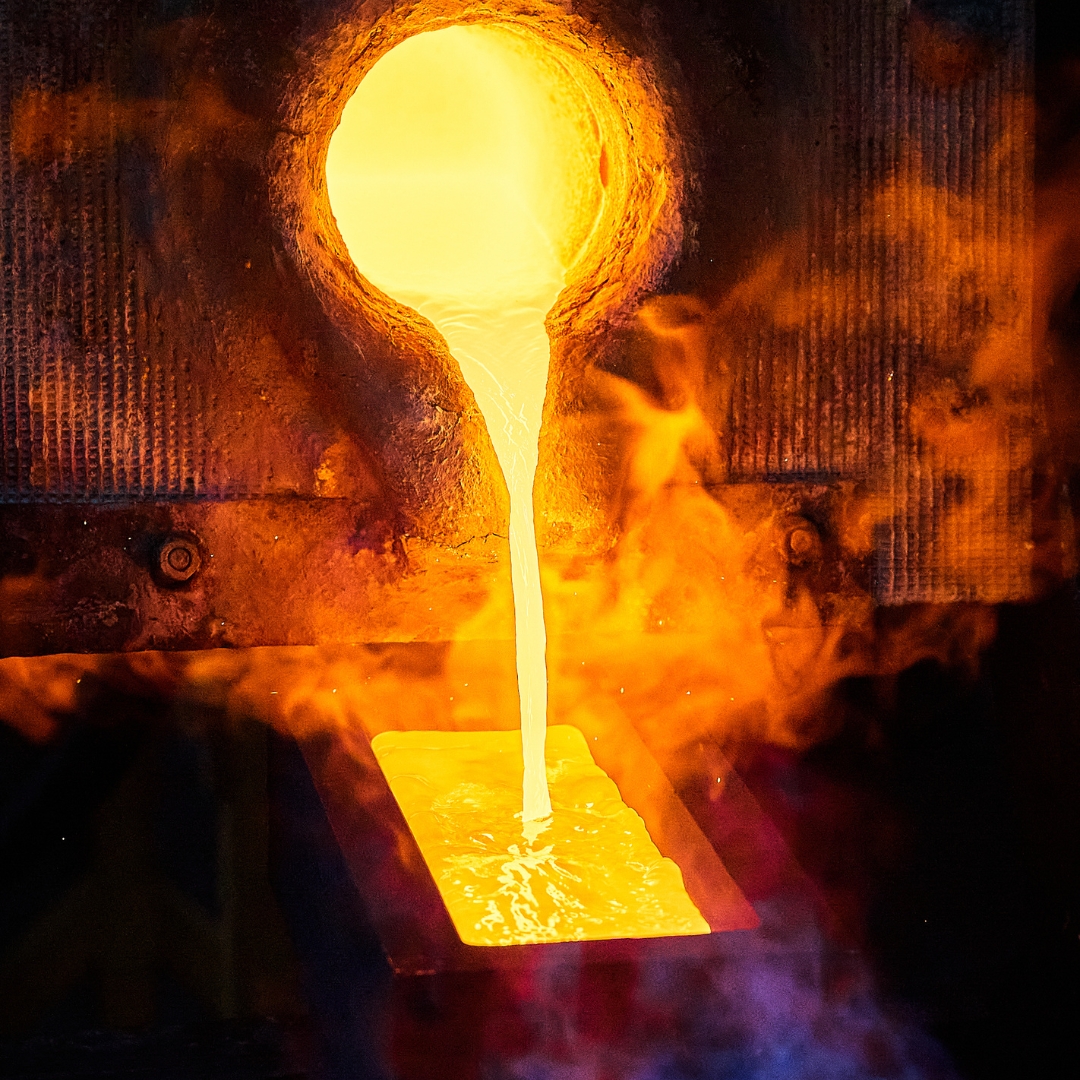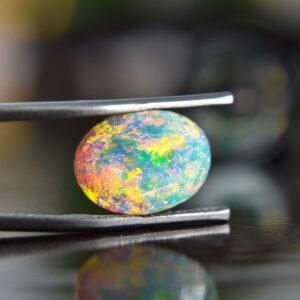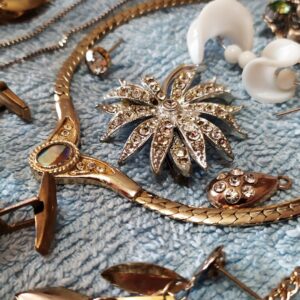Looking for the perfect metal for your engagement ring?
Choosing the right metal can make all the difference in the design process. But don’t worry, picking a metal doesn’t have to be complicated. Let’s explore the options together and uncover the advantages and disadvantages of each type before making your final decision.
As Long Island’s expert when it comes to custom engagement rings, I love to help guide clients in choosing the best options to create their dream engagement ring that will express their unique personality, hold up with their lifestyle and be a stunning piece that they’ll love and want to show off to all their friends!
So let’s explore what the different metal types are, their benefits and disadvantages, and which one will be perfect for you!
White Gold
If you’re after a stunning and popular choice, look no further than white gold. This metal is gradually surpassing platinum as the most preferred engagement ring option.
White Gold Benefits
- Versatility: White gold is incredibly versatile and can be easily paired with different gemstones, making it a flexible option for creating unique and customized designs. It complements a wide range of styles and looks, whether it’s a classic or contemporary design.
- Aesthetic Appeal: The bright and lustrous appearance of white gold gives it a clean and elegant look. It is often preferred by those who prefer the white or silvery color of precious metals over yellow gold.
- Affordability: Compared to platinum, white gold is generally more affordable, making it a budget-friendly alternative for those who desire a white metal look without breaking the bank.
- Durability: Although not as durable as platinum, white gold is still a strong and resilient metal. It is designed to withstand everyday wear and tear, making it suitable for long-term use.
- Hypoallergenic Options: White gold can be alloyed with metals such as palladium, which can make it hypoallergenic. This means it is less likely to cause allergic reactions, making it a suitable choice for those with sensitive skin.
White Gold Disadvantages
- Tarnishing and Discoloration: White gold is typically created by alloying yellow gold with other metals such as silver, nickel, or palladium. Over time, these alloys can cause white gold to tarnish, resulting in a slight yellowish tint. Regular cleaning and maintenance may be required to preserve its bright white appearance.
- Allergic Reactions: Some individuals may have allergies or sensitivities to the alloys used in white gold, particularly nickel. Nickel allergies can cause skin irritations or allergic reactions for those who are sensitive. It’s important to choose hypoallergenic alloys or opt for nickel-free white gold if you have known sensitivities.
- Maintenance and Rhodium Plating: To enhance the whiteness and shine of white gold, it is often plated with a thin layer of rhodium. This plating may wear off over time, requiring periodic re-plating to maintain the desired appearance. These maintenance costs should be considered when choosing white gold.
- Durability: While white gold is generally durable, it is slightly less durable than platinum. It may be more prone to scratches and dents due to its composition. Regular care, such as removing rings during activities that could cause damage, is recommended to keep white gold in good condition.
- Cost: Compared to yellow gold, white gold can be more expensive due to the additional processes involved in its creation, such as alloying and rhodium plating. The overall cost may vary depending on the purity of the gold and the market prices.
So, if you’re looking for a captivating choice that combines affordability, durability, and remarkable sparkle, white gold might just be your perfect match.

Yellow Gold
Yellow gold is the classic choice, embodying the natural charm of gold itself. When it comes to fine jewelry, yellow gold is usually blended with silver and copper to create stunning pieces. The hue of yellow gold depends on the percentage of pure gold in the alloy.
Yellow Gold Benefits
- Timeless Elegance: Yellow gold has a traditional and timeless appeal that never goes out of style. It exudes a sense of luxury and sophistication, making it a popular choice for those seeking a classic look.
- Durability: Gold in its purest form is a soft metal, but when alloyed with other metals like copper and zinc, it becomes more durable and suitable for everyday wear. Yellow gold engagement rings are known for their longevity and resistance to scratches and tarnish.
- Warmth and Glow: The rich, warm tone of yellow gold adds a beautiful glow to the skin, creating a flattering and radiant look. It complements a wide range of skin tones and enhances the brilliance of diamonds and gemstones.
- Versatility: Yellow gold is incredibly versatile and pairs well with a variety of diamond shapes and colored gemstones. It can be used in various ring settings and styles, allowing for endless customization options to create a unique and personalized engagement ring.
- Symbolism: Yellow gold is often associated with love, prosperity, and wealth. Choosing a yellow gold engagement ring can carry a deeper meaning and symbolize a lifelong commitment and enduring love.
- Easy Maintenance: Compared to other metals, yellow gold requires minimal maintenance. It does not tarnish or corrode easily, and a simple cleaning routine can keep it looking sparkling and new.
Which Yellow Gold to Choose?
Now, let’s talk about karats. Pure gold, in its 24 karat state, is too soft for jewelry. The higher the karat level, the softer the gold. Most fine jewelry is made from 18kt gold, consisting of 75 percent gold and 25 percent other metals. But, if toughness and strength are a priority, 14kt gold is widely used in every day jewelry since it contains 58.3% gold.
Yellow Gold Disadvantages:
- Prone to Scratches: Yellow gold, especially those with higher karat weights (such as 18k or 24k), can be more susceptible to scratches and dings compared to other metals. These scratches can affect the overall appearance of the ring over time.
- Allergies: Some individuals may have allergies or sensitivities to certain alloys used in yellow gold. Nickel, in particular, is a common allergen found in lower-quality gold alloys. It’s essential to choose a reputable jeweler that uses hypoallergenic alloys or opt for higher-purity gold to minimize the risk of an allergic reaction.
- Maintenance and Replating: Over time, the vibrant yellow color of gold may fade or dull due to exposure to elements, oils, and chemicals. To maintain its luster, yellow gold jewelry may require periodic professional polishing or replating to restore its original shine.
- Style and Trend Considerations: While yellow gold has a timeless appeal, it may not suit everyone’s personal style or match current fashion trends. Some individuals prefer the white or silvery tones of other metals, such as white gold or platinum.
If you love the richness of warm yellow and the timeless charm, then yellow gold is perfect for you!

Rose Gold
Rose gold is an alluring and exquisite combination of gold and copper, giving it a warm, reddish tint. This unique alloy is widely cherished in designer jewelry for its distinctive appearance. Did you know that rose gold is also referred to as red gold, pink gold, or even Russian gold due to its historical significance in Russia during the nineteenth century? The specific shade of red largely depends on the copper concentration in the alloy.
The more copper in the mix, the more vibrant the red hue becomes. Since gold has a bright yellow color and copper has a reddish tone, you’ll notice that the presence of more gold, like in 18k rose gold, tones down the redness, while higher copper content, like in 14k rose gold, intensifies the captivating red glow.
Rose Gold Benefits:
- Durability: Rose gold is strong and durable, making it resistant to nicks and scratches. The addition of copper to the gold alloy strengthens the metal, making it ideal for everyday wear.
- Timeless Beauty: Rose gold possesses a unique and romantic hue that sets it apart from other metals. Its warm pink color complements a variety of skin tones and adds a touch of elegance and femininity to any piece of jewelry.
- Tarnish Resistance: Unlike sterling silver, rose gold is generally resistant to tarnish. This means that it will retain its beautiful color and shine over time, requiring minimal maintenance.
- Versatility: Rose gold is incredibly versatile and pairs well with various gemstones and metals. It can be effortlessly incorporated into different jewelry designs, allowing for endless possibilities in creating personalized and custom pieces.
- Hypoallergenic Qualities: People with sensitive skin often find rose gold to be a suitable choice as it contains a lower percentage of nickel compared to other gold alloys. This makes it less likely to cause allergic reactions.
- Symbolism: Rose gold is associated with love, romance, and affection. Choosing a rose gold engagement ring can add sentimental value and evoke emotions, making it a meaningful choice for an everlasting commitment.
Rose Gold Disadvantages:
- Scratches: Like any other metal, rose gold can become scratched, especially when worn daily. It is generally less prone to scratches compared to yellow gold but may still develop surface marks over time.
- Allergies: Although rare, some individuals may have allergies or sensitivities to the copper alloy used in rose gold. If you have a known sensitivity to copper or other metal allergies, it’s important to consider this before choosing a rose gold ring.
- Maintenance: Rose gold jewelry may require occasional maintenance to maintain its appearance. Over time, the copper content in the alloy can cause the color of rose gold to slightly darken or develop a patina. Regular cleaning and polishing can help restore its original shine.
- Availability: While rose gold has gained popularity in recent years, it may not be as widely available as other metal options. This could limit the variety of styles and designs available when compared to more traditional options like yellow or white gold.
If you are drawn to pink and red hues and love the uniqueness and romance that these colors bring, then rose gold is perfect for you!

Platinum
When we think of rare and precious metals, platinum surely comes to mind. This extraordinary metal is found in only a few places on Earth, making it truly special.
With a global production of approximately 160 tons per year, compared to a whopping 1,500 tons of gold, it’s no wonder that platinum carries a higher price tag. But believe me when I say that its beauty and durability make it worth every penny.
In recent years, platinum has been stealing the spotlight, capturing the hearts of many. Its rich, even color and high luster make it a popular choice for engagement ring settings, perfectly showcasing the brilliance of the diamonds set within.
Platinum Benefits
- Durability: Platinum is an extremely durable metal, making it an excellent option for an engagement ring that will withstand daily wear and tear. It is highly resistant to scratching and does not wear away over time.
- Longevity: Platinum is known for its longevity, meaning it will retain its beauty and appearance for years to come. It does not tarnish, fade, or change color over time, ensuring your engagement ring looks as stunning as the day you got it.
- Hypoallergenic Properties: Platinum is hypoallergenic, making it an ideal choice for individuals with sensitive skin or metal allergies. It contains no nickel, which is a common allergen found in other metals.
- Enhanced Diamond Sparkle: Platinum’s white color enhances the brilliance and sparkle of diamonds, allowing them to shine even more brightly. This makes platinum an excellent choice if you want to maximize the beauty of your diamond.
- Rarity and Value: Platinum is a precious metal that is rarer and more valuable than gold. Its scarcity and unique properties contribute to its desirability and prestige.
- Strength and Security: Platinum is an incredibly strong and secure metal, providing a protective setting for your precious gemstones. Its strength ensures that your engagement ring can withstand everyday activities without compromising its integrity.
Platinum Disadvantages
- Softness and Scratches: Although platinum is durable, it is slightly softer than some white gold alloys. This means it may be more prone to scratching over time, leading to a dull appearance. However, these scratches can often create a unique patina that some people appreciate.
- Weight: Platinum is a dense metal, making it heavier than other metals like gold. Some individuals may find the weight uncomfortable or prefer a lighter option for everyday wear.
- Cost: Platinum is generally more expensive than gold, including white gold. The higher cost of platinum can impact the overall price of the engagement ring.
- Maintenance: While platinum does not tarnish, it can develop a patina over time, which some people may need to periodically polish to maintain its shine. Additionally, repairing platinum jewelry can be more challenging due to its high melting point, which poses a risk to gemstones or diamonds during the repair process.
If you love the pureness and simplicity of white, but don’t want to deal with a little more maintenance, then Platinum is perfect for you!

No matter which metal you choose, every one of them require some maintenance to keep it looking shiny and new, especially once you wear it with a wedding band.
But ultimately, it’s important to consider your personal preferences, budget, and lifestyle when choosing the metal for your engagement ring. Still not sure, I would love to help you choose the best option for your style and needs.
So which metal are you drawn to for your engagement ring? I’d love to know!
And if you’re Looking to create a unique custom engagement ring, I’d love to help.
It’s easy, just click the blue button below if you have any questions or need any help, I would love to chat with you!
If you have old jewelry, you can redesign it into your new custom piece! You can get some amazing Inspiration Ideas, Click the Button Below to get my Free Jewelry Redesign Inspiration Kit:





